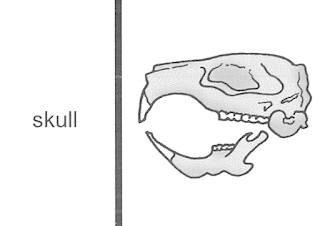This Unit was about the Skeletal System, which contains the bones, joints, cartilages, and ligaments. It is divided into two divisions: axial skeleton and appendicular skeleton. The Essential Understandings were the classification of bones, grow and microscopic anatomy of bones, functions and dysfunctions of the skeletal system, lifestyle choices affects bone health, relationship between structure and function to bones, tissues, and cells, and how the skeletal system works to help maintain homeostasis. This unit taught me (themes) about the disorders of the skeletal system and the different types of bones, the roles of vitamins, cells, and environment on bone density, and how the bone repairs itself after being fractured. It was really interesting to learn about the process of bone repair because I never have broken a bone, so before this, I didn't know how repairing bone worked. First, bleeding and inflammation produces a blood clot. After 48 hours, the clot softens and produces a mass of protein fibers called priceless. The Fibroblasts arrive and secrete dense connective tissue which replaces pro callus. Then Chrondroblasts and osteoblasts arrive. By the end of the first week, cartilage and bone appear throughout the site and eventually, osseous callus appears which can later heal the bone.
I want to learn more about the different disorders of the Skeletal System. We learned in little detail about arthritis (inflammation of joints), osteoporosis (bones lose minerals), scoliosis (abnormal curvature of spine), kyphosis (spine may develop a hump), lordosis (excessive curvature of lumbar spine), and reckless (softening and weakening of bones). I wonder about how the bone knows to release calcium into blood (in parathyroid hormone). I get that it is because level of calcium in blood goes down, but I wonder how that process works. I don't have any unanswered questions.
I have learned a lot in this class so far. Learning about the different systems in the body helps me understand the physiology and anatomy of the body better. Even though the pellet lab was smelly, I really liked that lab because we got to find bones in the pellet and identify which organism it was. I like those types of labs because it is up to the students to figure out the right answer. (
Owl Pellet Lab Link) I also liked the lab where we got to identify the different parts of the skeleton because it really helped me understand the anatomy of the bones.
The 20 Time Project has also helped me learn about different organizations and how they are making a difference in the world. (
20 Time Project Link). My New Years Goal was to listen and focus more in class and I think that I have definitely improved on those abilities. Another one of my goals was to not procrastinate, but I am still working on that goal currently.
Pictures:
 |
Owl Pellet Lab
|
 |
Eric Standing Next to the Skeleton, which we used in our Lab
|
 |
| Picture of leg bones |

















